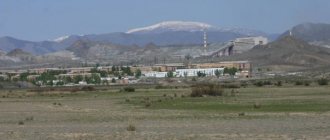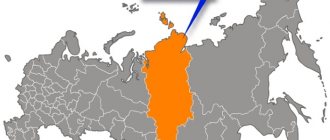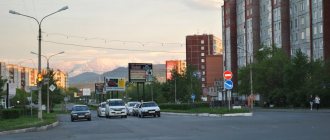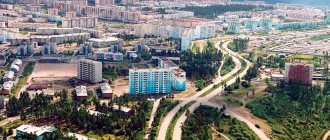Geographical position
Aleksandrovsk-Sakhalinsky rises in the western part of the island, washed by the Tatar Strait. The distance from Yuzhno-Sakhalinsk is 560 km, from the Tymovskoye railway junction - 60 km of gravel road. The airport in the village of Zonalnoye is 75 km away.
There are two ways to get to the city:
- By train – departs from Yuzhno-Sakhalinsk. You need to get to Tymovskoye station, then to the bus station. Buy a ticket for bus No. 503, going to the city of Aleksandrovsk-Sakhalinsky. A train ticket costs 730 rubles, a bus ticket costs 230 rubles.
- By personal transport - drive along the road, passing the settlements of Dolinsk, Makarov, Gastello, Poronaysk. After the town of Poronaysk, you should turn left and move west of the island to your destination.
Since 2015, the island has been in the UTC +11:00 time zone. In comparison with Moscow time, it is +8:00 hours. Therefore, it is designated as follows: MSK+8.
Alexandrovsk-Sakhalinsky
(Sakhalin region)
OKATO code:
64204501
Founded:
1869
City since:
1917 City of regional subordination
Center:
Aleksandrovsk-Sakhalinsky district
The city was formerly called:
| Alexandrovskaya | 1881 | |
| Alexandrovsky | 1881 | 1926 |
| Telephone code (reference phone) | |
| 42434***** | — |
| 424340**** | — |
Deviation from Moscow time, hours:
8
Geographic latitude:
50°54′
Geographic longitude:
142°09′
Altitude above sea level, meters:
10 Sunrise and sunset times in the city of Aleksandrovsk-Sakhalinsky
Historical information
In 1862, Alexandrovskaya Sloboda was located on the site of the current city. It was named so in honor of Tsar Alexander II. In the spring of 1869, the settlement turned into the Alexandrovskaya agricultural farm. Then, in 1881, the settlement was renamed Aleksandrovsky Post, which became a place of hard labor for criminals.
A huge prison was built with a foundry, metalworking, and carpentry workshops. Prisoners also harvested timber and worked in coal mines. Since 1884, the post separated from the Primorsky region and became the center of Sakhalin.
In May 1894, the island became the residence of the first military governor. This was Vladimir Merkazin, who did a lot to improve the economy and the lives of the townspeople. During his service, more villages and cities were built on the island than had appeared in previous decades.
In the period 1909-1914. Aleksandrovsky post was the administrative and economic center of the Sakhalin region. And after the revolution of 1917, the city was given a new name: Aleksandrovsk-Sakhalinsky. They did this to distinguish this point from settlements with the same name.
After the renaming, from 1926 the city was considered the center of the Sakhalin Okrug, then in 1932, after the formation of the Sakhalin region, it also became its center. And Alexandrovs-Sakhalinsky received its last territorial significance in 1947, becoming a regional center.
The size of the urban population has changed along with history. The largest numbers were observed in the period from 1935 to 1939. It had 24,900 inhabitants. Since 1970, there has been a gradual decline in people living in Aleksandrovsk-Sakhalinsk.
If in 2010 there were 13,400 residents in the city and region, then at the beginning of 2021 there were 11,000 left. According to statistics, the population level is declining for several reasons: economic decline, deteriorating social conditions, harsh weather conditions, remoteness from the center of Russia.
Russian Bath Kholmsk
Aleksandrovsk-Sakhalinsky is a city (since 1917) in Russia, the administrative center of the urban district “Aleksandrovsk-Sakhalinsky District” of the Sakhalin Region of Russia. Named in honor of Russian Emperor Alexander II. Organized as a military post, known since 1862 as the Alexander Post. Later it became one of the places of penal servitude of the Russian Empire, mainly for criminals who worked in logging and coal mines.
ALEXANDROVSK-SAKHALINSKY , a city of regional subordination in the Sakhalin region, the administrative center of the district of the same name; located on the western coast of Sakhalin Island, on the shore of the Tatar Strait at the foot of the Western Ridge of the Western Sakhalin Mountains, in the valleys of the shallow rivers Bolshaya Aleksandrovka and Malaya Aleksandrovka, 561 km north of Yuzhno-Sakhalinsk, 60 km from the Tymovskoye railway station, 75 km from Zonal airport.
There is a road to Yuzhno-Sakhalinsk. Port. Participants in the Amur expedition of 1851-55 under the command of G.I. Nevelsky described and mapped a bay in the Tatar Strait, the name Aleksandrovsky. Slobodka Aleksandrovskaya has been known since 1862 (name in honor of Emperor Alexander II). In 1869, the Alexandrovskaya agricultural farm was founded, which later became the village of Alexandrovka. In 1881, a military post (Alexandrovsky post) was formed, and since 1884 it has been the center of Sakhalin Island, separated from the Primorsky region into an independent administrative-territorial unit. Since 1894 it has been the residence of the military governor of Sakhalin. From 1909 to 1914 - Alexandrovsky post - the administrative center of the Sakhalin region. The city since 1917, in 1926 it was renamed Aleksandrovsk-Sakhalinsky (the definition is included in the name to distinguish it from other cities of the same name). In 1926-32 - Aleksandrovsk-Sakhalinsky was the center of the Sakhalin District, in 1932-47 - the newly formed Sakhalin Region, from 1947 - the regional center. Population (thousand people): 1959-22.2; 1970-20.3; 1979-19.1; 1989 - 19.1; 1992 - 19.4; 1998 - 16.8; 2002 - 12.8; 2005 -12.2. The administration of the Sakhalin hard labor (1869) and the civil administration of the island were located in Aleksandrovsk-Sakhalinsky. In 1881, a meteorological station was founded, a telegraph appeared, and communication was made via a cable laid along the bottom of the Tatar Strait. In 1920–25, Aleksandrovsk-Sakhalinsky was occupied by Japanese troops.
Aleksandrovsk-Sakhalinsky is a large port (the oldest on Sakhalin). In the 1950s-70s. had a steamship connection with Vladivostok, Nikolaevsky-on-Amur, and a ferry connection with the port of Vanino. The industry of Aleksandrovsk-Sakhalinsky arose simultaneously with the founding of the city. In 1880, a large convict prison was built, which had a carpentry, plumbing, foundry, lathe and other workshops. At the end of the 19th century. There was a brick factory in the city, logging, coal mining, and fishing were carried out. In Soviet times, Aleksandrovsk-Sakhalinsky became the center of the coal industry of Sakhalin Island (Mgachi mine). The city is home to Dueugol JSC, Aleksandrov-Sakhalin Sea Port JSC, a bakery, and forestry and fishing industry enterprises.
The temporary status of the administrative center turned Aleksandrovsk-Sakhalinsky into a center of culture and professional education. In the 1950s technical schools operated here: mining, forestry, Soviet trade; pedagogical school, paramedic and midwifery school, 2 schools of factory training; theater, libraries, clubs, research laboratory of the Pacific Institute of Fisheries and Oceanology. Museum of A.P. Chekhov opened in 1896, had about 1 thousand exhibits; in 1905 and 1925 it was almost completely plundered by the Japanese, subsequently transferred to Yuzhno-Sakhalinsk. In modern Aleksandrovsk-Sakhalinsky there are 2 museums: the local history museum named after. A.P. Chekhov, historical and literary “Chekhov and Sakhalin” (since 1990, in the house where the writer lived, who collected material for the book “Sakhalin Island” in 1890; in the museum park there is a monument to Chekhov, sculptor M.K. Anikushin). The building of the former treasury (1880, now the House of Creativity) has been preserved, 3 km from the city there is a lighthouse building (1864), where a bell cast in 1651 was brought in the last century. Near Aleksandrovsk-Sakhalinsky there is a tunnel built by convicts through Cape Zhonkier (1883) , rocks Three Brothers and Three Sisters.
Lit.: Senchenov I. A. Essays on the history of Sakhalin. Yuzhno-Sakhalinsk, 1957; Cities of the Sakhalin region. Yuzhno-Sakhalinsk, 1978; Materials for the collection of historical and cultural monuments of the Sakhalin region. Yuzhno-Sakhalinsk, 1983; Chesalin V.V. This is where the story began (About the city of Aleksandrovsk-Sakhalinsky). Yuzhno-Sakhalinsk, 1987
Climatic conditions
Aleksandrovsk-Sakhalinsky is considered a region of the Far North with a harsh climate.
Over 12 months there is a lot of precipitation in the form of snow and rain:
- annual precipitation is 620 mm;
- average air temperature – 0.9 °C;
- air humidity rises to 80%;
- wind gusts reach 5.1 m/s.
Temperature table:
| Month | The absolute minimum | Average minimum | average temperature |
| January | -41,0 | -20,4 | -16,5 |
| February | -37,2 | -19,1 | -14,7 |
| March | -34,1 | -12,5 | -8,1 |
| April | -26,0 | -3,5 | 4,3 |
| May | -9,0 | 2,3 | 10,7 |
| June | -2,5 | 7,5 | 11,5 |
| July | 0,5 | 11,7 | 15,2 |
| August | 1,6 | 13,1 | 16,6 |
| September | -2,6 | 8,6 | 12,3 |
| October | -15,1 | 1,9 | 5,1 |
| november | -26,1 | -7,5 | -4,6 |
| December | -36,9 | -15,9 | -12,3 |
Notes
- ↑ 12
www.gks.ru/free_doc/doc_2016/bul_dr/mun_obr2016.rar Population of the Russian Federation by municipalities as of January 1, 2021 - Great Russian Encyclopedia: In 30 volumes / Chairman of scientific editor. Council Yu. S. Osipov. Rep. edited by S. L. Kravets. T. 1. A - Questioning. - M.: Great Russian Encyclopedia, 2005. - 766 p.: ill.: map. (pp. 456-457)
- ↑ 123456789101112
www.MojGorod.ru/sahalin_obl/aleksahalin/index.html People's encyclopedia “My City”. Alexandrovsk-Sakhalinsky - [demoscope.ru/weekly/ssp/rus59_reg2.php All-Union Population Census of 1959. The size of the urban population of the RSFSR, its territorial units, urban settlements and urban areas by gender] (Russian). Demoscope Weekly. Retrieved September 25, 2013. [www.webcitation.org/6GDOghWC9 Archived from the original on April 28, 2013].
- [demoscope.ru/weekly/ssp/rus70_reg2.php All-Union Population Census of 1970 The size of the urban population of the RSFSR, its territorial units, urban settlements and urban areas by gender.] (Russian). Demoscope Weekly. Retrieved September 25, 2013. [www.webcitation.org/6GDOiMstp Archived from the original on April 28, 2013].
- [demoscope.ru/weekly/ssp/rus79_reg2.php All-Union Population Census of 1979 The size of the urban population of the RSFSR, its territorial units, urban settlements and urban areas by gender.] (Russian). Demoscope Weekly. Retrieved September 25, 2013. [www.webcitation.org/6GDOjhZ5L Archived from the original on April 28, 2013].
- [demoscope.ru/weekly/ssp/rus89_reg2.php All-Union Population Census of 1989. Urban population]. [www.webcitation.org/617x0o0Pa Archived from the original on August 22, 2011].
- [www.perepis2002.ru/ct/doc/1_TOM_01_04.xls All-Russian Population Census 2002. Volume. 1, table 4. Population of Russia, federal districts, constituent entities of the Russian Federation, districts, urban settlements, rural settlements - regional centers and rural settlements with a population of 3 thousand or more]. [www.webcitation.org/65AdCU0q3 Archived from the original on February 3, 2012].
- [www.gks.ru/bgd/regl/B09_109/IssWWW.exe/Stg/d01/tabl-21-09.xls Number of permanent population of the Russian Federation by cities, urban-type settlements and districts as of January 1, 2009]. Retrieved January 2, 2014. [www.webcitation.org/6MJmu0z1u Archived from the original on January 2, 2014].
- [sakhalinstat.gks.ru/wps/wcm/connect/rosstat_ts/sakhalinstat/resources/b7451680420c302db621fe2d59c15b71/5.pdf All-Russian Population Census 2010. Sakhalin region. Population of urban districts, municipal districts, urban and rural settlements, urban settlements, rural settlements]. Retrieved July 28, 2014. [www.webcitation.org/6RPB9plO8 Archived from the original on July 28, 2014].
- www.gks.ru/dbscripts/munst/munst64/DBInet.cgi?pl=8112027 Sakhalin region. Estimated resident population as of January 1, 2011-2016
- [www.gks.ru/free_doc/doc_2012/bul_dr/mun_obr2012.rar Population of the Russian Federation by municipalities. Table 35. Estimated resident population as of January 1, 2012]. Retrieved May 31, 2014. [www.webcitation.org/6PyOWbdMc Archived from the original on May 31, 2014].
- [www.gks.ru/free_doc/doc_2013/bul_dr/mun_obr2013.rar Population of the Russian Federation by municipalities as of January 1, 2013. - M.: Federal State Statistics Service Rosstat, 2013. - 528 p. (Table 33. Population of urban districts, municipal districts, urban and rural settlements, urban settlements, rural settlements)]. Retrieved November 16, 2013. [www.webcitation.org/6LAdCWSxH Archived from the original on November 16, 2013].
- [www.gks.ru/free_doc/doc_2014/bul_dr/mun_obr2014.rar Table 33. Population of the Russian Federation by municipalities as of January 1, 2014]. Retrieved August 2, 2014. [www.webcitation.org/6RWqP50QK Archived from the original on August 2, 2014].
- [www.gks.ru/free_doc/doc_2015/bul_dr/mun_obr2015.rar Population of the Russian Federation by municipalities as of January 1, 2015]. Retrieved August 6, 2015. [www.webcitation.org/6aaNzOlFO Archived from the original on August 6, 2015].
- The cape was named by the French navigator J.-F. de La Perouse in 1787, in honor of the famous French admiral and governor of New France - Taffanel Pierre Jacques, Marquis de la Jonquière (1685-1752)
- [www.gks.ru/free_doc/new_site/perepis2010/croc/Documents/Vol1/pub-01-05.xlsx Volume 1. Number and distribution of the population. 5. Population of Russia, federal districts, constituent entities of the Russian Federation, districts, urban settlements, rural settlements - regional centers and rural settlements with a population of 3 thousand people or more] // [www.gks.ru/free_doc/new_site/ perepis2010/itogi_2010.htm Results of the All-Russian Population Census]. — 2012.
Urban transport
Transportation within the city and suburbs of Aleksandrovsk-Sakhalinsky is carried out by Aleksandrovskoye PP LLC:
- City bus No. 1 follows the route Aleksandrovsk-Sakhalinsky State Farm - port. The number of flights on weekdays is 16, on weekends – 10. Ticket price is 18 rubles.
- Suburban bus No. 106 transports passengers from Aleksandrovsk-Sakhalinsky to the village of Due, 2 times a day. The ticket costs 55 rubles. one way.
- Suburban route: bus number 136 connects the city with the villages of Arkovo and Mgachi. On weekdays - 3 flights, on weekends - 2. The cost of the trip is 120 rubles.
- Bus No. 109 on the route Aleksandrovsk-Sakhalinsky - Polovinka, makes 2 trips a day, the cost of the trip is 28 rubles.
Hotels
In the city center, on Dzerzhinsky Street, 13a, there is a small and cozy hotel “Three Brothers”. The building has 15 rooms of varying comfort. There is a restaurant, cafe, bar, sauna and billiards on the hotel premises.
Single rooms are equipped with everything necessary for living. There is a TV, a wide bed, a bedside table, a wardrobe, a refrigerator and a kettle. The rooms are warm, clean and spacious. Tourists and guests of the island are offered to stay in the neighboring village of Tymovskoye, located 35 km along a direct road from Aleksandrovsk-Sakhalinsky.
There are three hotels in Tymovsky:
- North;
- Inn;
- Versailles.
All rooms are equipped with comfortable furniture and household electrical appliances.
Museums
Alexandrovsk-Sakhalinsky has 2 museum complexes:
- historical and literary “Chekhov and Sakhalin”;
- Local Lore named after A.P. Chekhov.
The first is located in the building where Chekhov lived in the fall of 1890. At this time, the writer was collecting notes and facts for the future book “Sakhalin Island”. The museum has a long and unusual history.
It was opened after the decree of the Governor of Sakhalin V. Merkazin. The museum was created by political exiles L. Sternberg and B. Pilsudski. At first it existed without a name, but in the fall of 1990 the institution was named after the name of the famous writer. The exhibition materials tell about the life of Chekhov and his impressions of the penal servitude of the island. Personal letters, notes, drafts are presented.
Particular attention is drawn to the large book and illustration exhibition “Literary”, consisting of sections:
- Chekhov's route to Sakhalin;
- writer's lunch with K. Landsberg;
- the home and family of the island's governor;
- hard labor;
- work on the work “Sakhalin Island”;
- Chekhov's return home.
The Stanok museum complex, opened in May 2021, is unique in its appearance and significance.
This is a kind of reconstruction of buildings from convict times, including the following blocks:
- inn;
- horse stall;
- forge;
- post office and telegraph office;
- prisoner's cell and warden's room.
The museum is located on Chekhov Street, 19. In a quiet park near the building there is a monument to the great Chekhov, created by sculptor M.K. Anikushin.
- Open from 10.00 to 17.00.
- Lunch – from 13.00 – 14.00.
- Closed: Monday, Tuesday.
- Ticket price – 50 – 100 rubles.
Museum of Local Lore named after. A.P. Chekhov is located on Tsapko Street, 3. The building was built in 1915 as a residential building and was occupied by radio station workers. In 1917, Alexander Tsapko, chairman of the city revolutionary executive committee, lived there. He was tortured and killed by the Japanese. Local residents named a city street after the hero.
The exhibitions of the local history museum tell visitors about the historical life of the city, its economy, and nature. A separate exhibition is dedicated to the nature of the island. The museum's operating schedule is identical to that of the historical and literary museum "Chekhov and Sakhalin".
Links
20-100 thousand people. Korsakov • Kholmsk • Okha 10-20 thousand people. Poronaysk • Dolinsk • Nevelsk • Aleksandrovsk-Sakhalinsky • Uglegorsk • Nogliki 3-10 thousand people Aniva • Shakhtersk • Tymovskoye •
Smirnykh
• Makarov •
Yuzhno-Kurilsk
•
Troitskoye
• Tomari •
Gornozavodsk
•
Bykov
•
Sokol
•
Chekhov
•
KrasnogorskStory Treaties (Simodsky 1855 • St. Petersburg 1875 • Portsmouth 1905 • Peking 1925) • Russo-Japanese War (Actions on Sakhalin) • Karafuto • Occupation of Northern Sakhalin • Soviet-Japanese War (Operations: Yuzhno-Sakhalinsk • Kuril • Landings: Maoka • Otomari • Thoreau) • Repatriation of the Japanese • Sakhalinlag • Construction 506 • Earthquakes and tsunamis (North Kurilsk 1952 • Neftegorsk 1995 • Nevelsk 2007) • Typhoon 1981 Symbols Coat of Arms • Anthem • Flag Geography Volcanoes • Mountain peaks • Mountain ranges • Nature reserves and sanctuaries • Climate • Lakes • Islands (Sakhalin • Kuril Islands) • Plains • Rivers Power Governor • Government • Regional Duma • Regional Court • Regional Arbitration Court • Charter • Twin Cities Administrative division Sakhalin department (1884-1909) • Sakhalin region (1909-1920) • Sakhalin district (1925-1932) • South Sakhalin region (1945-1947) • Coats of arms • Flags • Regional diocese • Apostolic prefecture Education Schools • Universities Healthcare Health care institutions Population Ainu • Koreans • Nivkhs Economy Enterprises and companies (pulp and coal plant • Mines) • Tourism • Offshore projects Transport Bus systems (Yuzhno-Sakhalinsk • Kholmsk) • Highways (P487 • A391 • P490 • A392) • Airports • Railway (Stations and platforms) • Seaports Connection Internet • Television • Radio stations • Mail • Media Culture Attractions • Museums • Theaters Sport Athletic facilities Portal "Sakhalin Region" •
Project "Sakhalin Region"Baltic Sea Vyborg • Vysotsk • Kaliningrad • St. Petersburg (Bolshoi Port and Passenger Port) • Primorsk • Ust-Luga Barents Sea Varandey • Murmansk • Naryan-Mar White Sea Arkhangelsk • Belomorsk • Vitino • Kandalaksha • Kem • Mezen • Onega • Severodvinsk Bering Sea Anadyr • Beringovsky • Provideniya • Egvekinot East Siberian Sea Pevek • Chersky Kara Sea Amderma • Dixon • Dudinka • Igarka • Sabetta Caspian Sea¹ Astrakhan • Makhachkala • Olya Laptev Sea Tiksi • Khatanga Sea of Okhotsk Korsakov • Magadan • Moskalvo • Cape Lazarev • Nikolaevsk-on-Amur • Okhotsk • Poronaysk • Prigorodnoye Pacific coast of Kamchatka and Kuril Islands Petropavlovsk-Kamchatsky Black Sea Anapa • Gelendzhik • Evpatoria4 • Kerch (commercial • fishing • Kamysh-Burun • Port “Crimea”)4 • Novorossiysk • Sevastopol4 • Sochi (commercial and passenger • cargo) • Taman² • Tuapse • Feodosiya4 • Chernomorsk4 • Yalta4 Chukchi Sea Cape Schmidt ³ Sea of Japan Aleksandrovsk-Sakhalinsky • Boshnyakovo • Vanino • Vladivostok • Vostochny • De-Kastri • Danube • Zarubino • Nakhodka • Nevelsk • Olga • Plastun • Posyet • Preobrazhenie • Rudnaya Pristan • Svetlaya • Slavyanka • Sovetskaya Gavan • Uglegorsk • Kholmsk • Shakhtersk ¹ Caspian Sea is actually a lake.
² The port of Taman
is under construction, but is already open for traffic.
³ The port of Cape Shmidt
has been part of the port of Pevek since 2006. 4 Located on the territory that is the subject of a territorial dispute between Russia and Ukraine.
Sights and interesting places
Alexandrovsk-Sakhalin memorial places and interesting attractions attract tourists who usually visit the following places:
- An ancient building , built in 1880. Before the revolution, it housed the Treasury of the Alexander Post. Today it is the House of Art and Creativity, where all cultural city events take place and exhibitions of paintings, crafts, and drawings are held.
- Lighthouse – stands 3 km outside the city, on the hills of Cape Jonquière. Built in 1864. Then rebuilt several times. At first it was made of wood, with a hexagonal tower equipped with a bell and a lighting fixture. Nearby there was a barracks, outbuildings and a bathhouse. In Soviet times, the lighthouse was updated, the walls were built of concrete and stone.
- Aleksandrovsky Tunnel - leads to the lighthouse, cut through the rock by hand by convicts. Famous for its sharp bend and 87-meter length. Its name glorifies the Russian Emperor Alexander II.
- “Three Brothers” - the rocks are located to the right of Cape Jonquière, rising above the sea. They are a symbol of Fr. Sakhalin, depicted on the coat of arms of the Aleksandrovsk-Sakhalin region. A favorite haunt of seagulls and seals. To the left of the cape you can see the group of rocks “Three Sisters”. They are not so popular and famous, but they are also mysterious, like the “brothers” rocks.
- Obelisk to fallen soldiers - erected in the fall of 1947. The monument glorifies the heroes who fell during the liberation of Sakhalin from the Japanese. The design of the monument was made by the architect-builder Timofey Lukyanov.
- Iraida - an unusual waterfall, formed in the center of Cape Spasenny. It is located outside the city, south of the village of Douai. In winter it freezes and looks like a huge 70-meter icicle. Attracts mountaineers and ice climbers.
The frozen Irada waterfall in Aleksandrovsk-Sakhalinsky is a favorite place for rock climbers - City cemetery - there lies “Sonka the Golden Hand” - the world famous thief and adventurer, Sofya Bluvshtein. She served her sentence at hard labor at the Aleksandrovsky post. According to one legend, the woman is buried in the old cemetery of the island. Local archives contain documents and photographs of the legendary criminal.
Entertainment
Aleksandrovsk-Sakhalinsky, although small, has enough places for recreation and entertainment for island residents and tourists:
- cafeteria "Three Brothers";
- central House of Culture;
- House of Creativity;
- recording studio "Stereophonic";
- libraries;
- beach;
- rental of boats and boats.
The most visited city on the island, Alexandrovsk-Sakhalinsky, has become a kind of Mecca for travelers, tourists and climbers. Interesting history, nature, architectural monuments attract people from all over Russia.
Only in this area can you find pristine natural places: powerful waterfalls, steep cliffs, snow-capped mountains. And see thickets of Red Book plants, rare animals and birds.
Article design: Vladimir the Great











